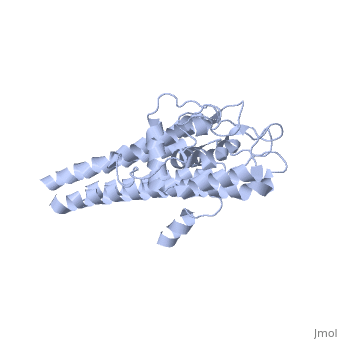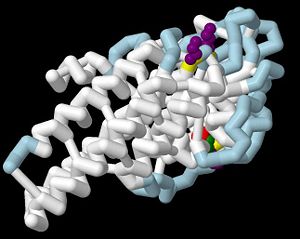VlsE
From Proteopedia
(Difference between revisions)
| (4 intermediate revisions not shown.) | |||
| Line 1: | Line 1: | ||
| - | <StructureSection load='1l8w' size='400' side='right' scene='' caption='VlsE lipoprotein | + | <StructureSection load='1l8w' size='400' side='right' scene='' caption='VlsE lipoprotein [[1l8w]]'> |
[[Image:1L8W_2_pdb.jpg|thumb|300px|left|VlsE]] | [[Image:1L8W_2_pdb.jpg|thumb|300px|left|VlsE]] | ||
{{Clear}} | {{Clear}} | ||
| Line 6: | Line 6: | ||
[http://en.wikipedia.org/wiki/Borrelia_burgdorferi ''Borrelia burgdorferi'']' is a bacterium that is classified under a class of spirochetes of the genus Borrelia. It is the causative agent of [http://www.ncbi.nlm.nih.gov/pubmedhealth/PMH0002296/ Lyme disease], which is a multistage infection that is transmitted by the [http://cid.oxfordjournals.org/content/11/Supplement_6/S1451.short Ixodes tick]. The tick undergoes a 4-stage cycle: egg, larva, nymph, and adult. The tick that is most likely to carry ''Borrelia burgdorferi'' is in the nymph stage and it can take from 24 to 48 hours of attachment for the bacteria to transfer to the host<ref>PMID: 15117014</ref>. Infection of spirochetes can lead to neurological and cardiovascular infections and arthralgic abnormalities<ref>PMID: 11923306</ref>. | [http://en.wikipedia.org/wiki/Borrelia_burgdorferi ''Borrelia burgdorferi'']' is a bacterium that is classified under a class of spirochetes of the genus Borrelia. It is the causative agent of [http://www.ncbi.nlm.nih.gov/pubmedhealth/PMH0002296/ Lyme disease], which is a multistage infection that is transmitted by the [http://cid.oxfordjournals.org/content/11/Supplement_6/S1451.short Ixodes tick]. The tick undergoes a 4-stage cycle: egg, larva, nymph, and adult. The tick that is most likely to carry ''Borrelia burgdorferi'' is in the nymph stage and it can take from 24 to 48 hours of attachment for the bacteria to transfer to the host<ref>PMID: 15117014</ref>. Infection of spirochetes can lead to neurological and cardiovascular infections and arthralgic abnormalities<ref>PMID: 11923306</ref>. | ||
| + | See also:<br /> | ||
| + | [[The_surface_lipoprotein_E_(VlsE)_of_the_Lyme_disease_spirochete_bacterium]]<br /> | ||
| + | [[VlsE_of_Borrelia]]<br /> | ||
| + | [[StudioG24SecL04Tpc5]] | ||
| - | Found on the surface of the ''Borrelia burgdorferi'' is the lipoprotein <scene name='G21SecL01Tpc5/Vlse/1'>VlsE</scene>. VlsE stands for Vmp-like sequence, Expressed, where Vmp is short for variable major protein.<ref>PMID: 10569796</ref> It was discovered that VlsE produces a strong antibody response by the immune system, but also has the ability to conceal itself due to an antigenic variation system surrounding the protein. Wrapped by the variable regions are the invariable regions, which are more susceptible to the binding of antibodies. By protecting the more vulnerable regions within the protein it allows the bacteria to manifest in the body without being detected, creating an effective strategy to evade the immune system. | + | |
| + | Found on the surface of the ''Borrelia burgdorferi'' is the lipoprotein <scene name='G21SecL01Tpc5/Vlse/1'>VlsE</scene>. '''VlsE''' stands for Vmp-like sequence, Expressed, where Vmp is short for variable major protein.<ref>PMID: 10569796</ref> It was discovered that VlsE produces a strong antibody response by the immune system, but also has the ability to conceal itself due to an antigenic variation system surrounding the protein. Wrapped by the variable regions are the invariable regions, which are more susceptible to the binding of antibodies. By protecting the more vulnerable regions within the protein it allows the bacteria to manifest in the body without being detected, creating an effective strategy to evade the immune system. | ||
==Structural Overview== | ==Structural Overview== | ||
| Line 33: | Line 38: | ||
Lyme disease presents with symptoms of [http://onlinelibrary.wiley.com/doi/10.1111/j.1749-6632.1988.tb31834.x/abstract erythema migrans (EM)], arthritis, heart disease, and neurologic abnormalities. If not treated early these symptoms can cause permanent damage to the relative tissues. Using antibiotics, Lyme Disease can be treat and usually cured; however it is hard to diagnose early on and usually goes unnoticed until irreversible symptoms arise. Though, VlsE's function is not known it can be used to diagnose Lyme Disease through invariable region-6. Invariable region-6 (IR6) is important for diagnosis because it is highly reactive to antibody interaction. Although, IR6 has only 13.7% of its surface visible to antibody interactions this is the only site capable for use in human diagnostics.<ref>PMID:11923306</ref> Contained in alpha helix 10 it is composed of 26 peptides, four of which establish antibody adhesion. Amino acids <scene name='G21SecL01Tpc5/Lys-276_and_gln-279/5'>Lys-276(Green), Gln-279(Purple)</scene>, <scene name='G21SecL01Tpc5/Lys-276_and_gln-279/9'>Lys-291, and Lys-295</scene> all contain polar regions that branch out into the extra cellular space. Unlike most residues Lys and Gln side chains can perform a wider range of movements to establish better kinetics with paratopes, permitting higher affinity. Recently these regions have been the target for serodiagnosis using immunoassays. In order to do this, Human blood serum is mixed with detergent to lyse the protein and expose IR6. [http://www.ncbi.nlm.nih.gov/pubmed/11023468 Western blot and ELISA] assays are then used to determine the presents of the pathogen.<ref>PMID:21778118</ref> Depending on the results one or more tests are performed to establish an accurate measure. This procedure is highly expensive nevertheless and is usually performed on patients within Ixode tick infested areas. | Lyme disease presents with symptoms of [http://onlinelibrary.wiley.com/doi/10.1111/j.1749-6632.1988.tb31834.x/abstract erythema migrans (EM)], arthritis, heart disease, and neurologic abnormalities. If not treated early these symptoms can cause permanent damage to the relative tissues. Using antibiotics, Lyme Disease can be treat and usually cured; however it is hard to diagnose early on and usually goes unnoticed until irreversible symptoms arise. Though, VlsE's function is not known it can be used to diagnose Lyme Disease through invariable region-6. Invariable region-6 (IR6) is important for diagnosis because it is highly reactive to antibody interaction. Although, IR6 has only 13.7% of its surface visible to antibody interactions this is the only site capable for use in human diagnostics.<ref>PMID:11923306</ref> Contained in alpha helix 10 it is composed of 26 peptides, four of which establish antibody adhesion. Amino acids <scene name='G21SecL01Tpc5/Lys-276_and_gln-279/5'>Lys-276(Green), Gln-279(Purple)</scene>, <scene name='G21SecL01Tpc5/Lys-276_and_gln-279/9'>Lys-291, and Lys-295</scene> all contain polar regions that branch out into the extra cellular space. Unlike most residues Lys and Gln side chains can perform a wider range of movements to establish better kinetics with paratopes, permitting higher affinity. Recently these regions have been the target for serodiagnosis using immunoassays. In order to do this, Human blood serum is mixed with detergent to lyse the protein and expose IR6. [http://www.ncbi.nlm.nih.gov/pubmed/11023468 Western blot and ELISA] assays are then used to determine the presents of the pathogen.<ref>PMID:21778118</ref> Depending on the results one or more tests are performed to establish an accurate measure. This procedure is highly expensive nevertheless and is usually performed on patients within Ixode tick infested areas. | ||
</StructureSection> | </StructureSection> | ||
| + | ==3D structures of VlsE== | ||
| + | |||
| + | Updated on {{REVISIONDAY2}}-{{MONTHNAME|{{REVISIONMONTH}}}}-{{REVISIONYEAR}} | ||
| + | |||
| + | [[1l8w]] – VlsE – ''Borrelia burgdorferi''<br /> | ||
__NOTOC__ | __NOTOC__ | ||
Current revision
| |||||||||||
3D structures of VlsE
Updated on 16-January-2019
1l8w – VlsE – Borrelia burgdorferi
See also SB2013 L04gr5
Notes
- References are cited once per section due to technical difficulties. Please note that references are referred to more than once per section because of this error.
Additional Links
References
- ↑ Lo Re V 3rd, Occi JL, MacGregor RR. Identifying the vector of Lyme disease. Am Fam Physician. 2004 Apr 15;69(8):1935-7. PMID:15117014
- ↑ Eicken C, Sharma V, Klabunde T, Lawrenz MB, Hardham JM, Norris SJ, Sacchettini JC. Crystal structure of Lyme disease variable surface antigen VlsE of Borrelia burgdorferi. J Biol Chem. 2002 Jun 14;277(24):21691-6. Epub 2002 Mar 28. PMID:11923306 doi:10.1074/jbc.M201547200
- ↑ Liang FT, Philipp MT. Analysis of antibody response to invariable regions of VlsE, the variable surface antigen of Borrelia burgdorferi. Infect Immun. 1999 Dec;67(12):6702-6. PMID:10569796
- ↑ Eicken C, Sharma V, Klabunde T, Lawrenz MB, Hardham JM, Norris SJ, Sacchettini JC. Crystal structure of Lyme disease variable surface antigen VlsE of Borrelia burgdorferi. J Biol Chem. 2002 Jun 14;277(24):21691-6. Epub 2002 Mar 28. PMID:11923306 doi:10.1074/jbc.M201547200
- ↑ Liang FT, Philipp MT. Analysis of antibody response to invariable regions of VlsE, the variable surface antigen of Borrelia burgdorferi. Infect Immun. 1999 Dec;67(12):6702-6. PMID:10569796
- ↑ Liang FT, Philipp MT. Analysis of antibody response to invariable regions of VlsE, the variable surface antigen of Borrelia burgdorferi. Infect Immun. 1999 Dec;67(12):6702-6. PMID:10569796
- ↑ Eicken C, Sharma V, Klabunde T, Lawrenz MB, Hardham JM, Norris SJ, Sacchettini JC. Crystal structure of Lyme disease variable surface antigen VlsE of Borrelia burgdorferi. J Biol Chem. 2002 Jun 14;277(24):21691-6. Epub 2002 Mar 28. PMID:11923306 doi:10.1074/jbc.M201547200
- ↑ Zhang J and Norris S. 1998. Genetic Variation of the Borrelia burgdorferi’’ Gene vlsE Involves Cassette-Specific, Segmental Gene Conversion. Infection and Immunity. 66(8): 3698–3704
- ↑ Sung S, McDowell J, and Marconi R. 2001. Evidence for the Contribution of Point Mutations to vlsE Variation and for Apparent Constraints on the Net Accumulation of Sequence Changes in vlsE during Infection with Lyme Disease Spirochetes. Journal of Bacteriology183(20): 5855–5861.
- ↑ Anguita J, Thomas V, Samanta S, Persinski R, Hernanz C, Barthold SW, Fikrig E. Borrelia burgdorferi-induced inflammation facilitates spirochete adaptation and variable major protein-like sequence locus recombination. J Immunol. 2001 Sep 15;167(6):3383-90. PMID:11544329
- ↑ Liang FT, Philipp MT. Analysis of antibody response to invariable regions of VlsE, the variable surface antigen of Borrelia burgdorferi. Infect Immun. 1999 Dec;67(12):6702-6. PMID:10569796
- ↑ Liang FT, Aberer E, Cinco M, Gern L, Hu CM, Lobet YN, Ruscio M, Voet PE Jr, Weynants VE, Philipp MT. Antigenic conservation of an immunodominant invariable region of the VlsE lipoprotein among European pathogenic genospecies of Borrelia burgdorferi SL. J Infect Dis. 2000 Nov;182(5):1455-62. Epub 2000 Oct 9. PMID:11023468 doi:10.1086/315862
- ↑ Eicken C, Sharma V, Klabunde T, Lawrenz MB, Hardham JM, Norris SJ, Sacchettini JC. Crystal structure of Lyme disease variable surface antigen VlsE of Borrelia burgdorferi. J Biol Chem. 2002 Jun 14;277(24):21691-6. Epub 2002 Mar 28. PMID:11923306 doi:10.1074/jbc.M201547200
- ↑ Eicken C, Sharma V, Klabunde T, Lawrenz MB, Hardham JM, Norris SJ, Sacchettini JC. Crystal structure of Lyme disease variable surface antigen VlsE of Borrelia burgdorferi. J Biol Chem. 2002 Jun 14;277(24):21691-6. Epub 2002 Mar 28. PMID:11923306 doi:10.1074/jbc.M201547200
- ↑ Chandra A, Latov N, Wormser GP, Marques AR, Alaedini A. Epitope mapping of antibodies to VlsE protein of Borrelia burgdorferi in post-Lyme disease syndrome. Clin Immunol. 2011 Oct;141(1):103-10. Epub 2011 Jul 2. PMID:21778118 doi:10.1016/j.clim.2011.06.005
Proteopedia Page Contributors and Editors (what is this?)
Michal Harel, Jessica M Svoboda, Christine Paulose, Cindy Lee, Alexander Berchansky, Jaime Prilusky, Lukas Klees


